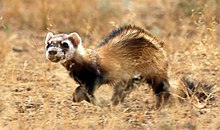| Steppe polecat | |
|---|---|

| |
| At the Stepnoi Sanctuary | |
| Scientific classification | |
| Domain: | Eukaryota |
| Kingdom: | Animalia |
| Phylum: | Chordata |
| Class: | Mammalia |
| Order: | Carnivora |
| Family: | Mustelidae |
| Genus: | Mustela |
| Species: | M. eversmanii
|
| Binomial name | |
| Mustela eversmanii (Lesson, 1827)
| |

| |
| Steppe polecat range | |
The steppe polecat (Mustela eversmanii), also known as the white or masked polecat, is a species of mustelid native to Central and Eastern Europe and Central and East Asia.It is listed as Least Concern on the IUCN Red List because of its wide distribution, occurrence in a number of protected areas, and tolerance to some degree of habitat modification.[1] It is generally of a very light yellowish colour, with dark limbs and a dark mask across the face.[2] Compared to its relative, the European polecat, the steppe polecat is larger in size and has a more powerfully built skull.[3]
The steppe polecat is a nomadic animal which typically only settles in one area until its prey, mainly ground squirrels, are extirpated.[4] It mates from March to May, and generally gives birth to litters of three to six kits, which attain their full growth at the age of two years.[5] It hunts for larger prey than the European polecat, including pikas and marmots.[6]
- ^ a b Maran, T.; Skumatov, D.; Abramov, A.V. & Kranz, A. (2016). "Mustela eversmanii". IUCN Red List of Threatened Species. 2016: e.T29679A45203762. doi:10.2305/IUCN.UK.2016-1.RLTS.T29679A45203762.en. Retrieved 19 November 2021.
- ^ Cite error: The named reference
s1136was invoked but never defined (see the help page). - ^ Cite error: The named reference
s1143was invoked but never defined (see the help page). - ^ Cite error: The named reference
s1169was invoked but never defined (see the help page). - ^ Cite error: The named reference
s1172was invoked but never defined (see the help page). - ^ Cite error: The named reference
s1166was invoked but never defined (see the help page).
